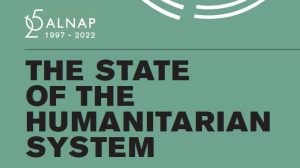Global humanitarian system failing the most desperate
The global humanitarian sector is struggling to keep pace with soaring needs and costs and reform is coming too slowly, a new landmark study has warned.
The ‘State of the Humanitarian System 2022’ report, published by ALNAP, a global network of humanitarian agencies, says the fractured state of the international community is undermining the delivery of humanitarian aid while leaving hundreds of millions facing cascading crises of conflict, COVID-19 and climate disasters,
It says a breakdown of trust and cooperation within the international community is failing people affected by disasters and preventing humanitarian aid workers from doing their jobs.
And international agreements are being flouted globally, compromising the ability of the humanitarian system to respond.
The report is the latest to measure progress and setbacks across the global emergency aid sector and it comes ahead of a meeting of world leaders at the UN General Assembly where humanitarian crises will be high on the agenda.
 The report reveals how war, hunger, climate change, and the economic impacts of COVID-19 combined in unprecedented ways to drive over 250 million people into crisis in 2021, doubling the number of people in need of assistance in just five years.
The report reveals how war, hunger, climate change, and the economic impacts of COVID-19 combined in unprecedented ways to drive over 250 million people into crisis in 2021, doubling the number of people in need of assistance in just five years.
“A lack of coordinated global leadership is emboldening several national governments and armed groups to deploy outright physical violence or insidious tactics of menace and obstruction to prevent the delivery of impartial humanitarian aid,” the report says.
“Attacks on aid workers rose by 54 per cent between 2017 and 2020 and local humanitarian responders regularly face intimidation and threat of physical violence,” it says.
The report combines new and existing data to provide a comprehensive overview of humanitarian need and assistance for people facing crisis across the world. It shows that the need for humanitarian aid reached an all-time high between 2018 and 2021, peaking in 2020 due to the COVID-19 pandemic.
While funding for humanitarian aid reached an estimated $US 31.3bn in 2021, almost double what it had been a decade before, humanitarian organisations were only able to reach 46 per cent of those identified as being in need of support.
Conflicts, the number of which rose from 83 in 2010 to 175 in 2020, are preventing relief workers from doing their jobs and driving the highest-ever totals of refugees and people fleeing violence.
The report says that even before the Russian invasion of Ukraine, around 80 million people worldwide had been forced to flee their homes because of conflict or climate change, the highest ever number.
The majority of these – over 53 million people – were internally displaced, and while disasters remained the predominant cause of internal displacement, in 2021 conflict-induced internal displacement reached its highest level in a decade.
Worryingly, the report shows how conflict situations are forcing humanitarians to compromise on their principles of humanity, impartiality, neutrality and independence in order to reach people affected by crisis.
As a result, crisis affected people in multiple countries say they are not receiving enough support, and some feel left behind by the international community.
There are examples of intelligence officials vetting lists of relief recipients and governments expelling or suspending agencies if they speak out against abuses.
Aid workers have reported having to choose between delivering aid only to people living in territory controlled by specific factions or delivering no aid at all.
Lead author of the report Dr Alice Obrecht said the humanitarian system was under direct threat in countries around the globe.
“We cannot take multilateral support for international humanitarian law as a given. In the face of escalating conflicts and the impacts of COVID-19 and climate change, crisis is becoming the norm,” Dr Obrecht said.
“The world must renew its commitment to the global social contract, with a respect for the rights of people affected by crisis at the centre of this,” she said.
The head of Kenya’s Red Cross Dr Asha Mohammed said recent gains in the capacity of the humanitarian system had been lost.
“Unfortunately, this report shows that we have backtracked from the gains made during COVID-19 when a big part of the humanitarian response was by local actors,” Dr Mohammed said that the launch of the report.
“The future of humanitarian work is local and for meaningful change to happen we cannot continue with cosmetic approaches. To reach the last mile and enhance cost effective approaches in a shrinking funding environment, we must ensure local actors are well positioned and supported,” she said.The report said the last few years had been characterised by global emergencies and that the consequences of a lack of international cooperation were clear.
“If we carry on as we are, the implications for everyone – wherever they are in the world, rich and poor countries alike – are dire; as the fuel supply crisis and summer heatwaves have shown, no-one is immune from the impacts. We need a new multilateralism to address our common challenges. The humanitarian endeavour, while far from being the only source of support for people in crisis, is an example of humanity at its best. It’s not about aid, but about compassion and global solidarity,” the report concluded
Read the full report here: State of the Humanitarian System
Read more here: The New Humanitarian | Key takeaways from the latest snapshot of the humanitarian system












